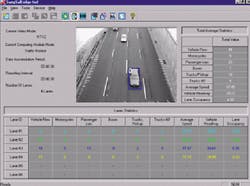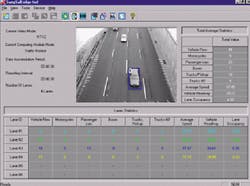Neural networks target traffic management
To manage automobile traffic and improve the use of today's roads, transportation planners need powerful traffic-monitoring vision tools. By collecting data about vehicle travel directions, volumes, and speeds, planners can better understand and implement traffic patterns. Once these patterns are understood, roadway and traffic-control strategies can be developed to reduce traffic congestion, accidents, and travel time. Real-time collection, interpretation, and transmission of such data can also improve management of emergency resources, reduce accidents, and direct and restore traffic flow.
A few years ago, Nestor Traffic Systems (Providence, RI) developed a neural-network-based video traffic-monitoring technology to address the needs of transportation planners. Of the company's two systems, TrafficVision provides real-time video-based traffic monitoring and automated incident detection; CrossingGuard is a video-based automated enforcement system that records red-light violations to reduce the risk of crashes at intersections (see Vision Systems Design, April 1999, p. 12).
Recognizing a market opportunity, RC Module (Moscow, Russia) has introduced a neural-network-based traffic-monitoring system, the NeuroMatrix Traffic Monitor-E. Like the Nestor systems, RC Module's system uses a neural-network IC to perform image correction, segmentation, tracking, classification, and measurement. At the heart of the system is a stand-alone embedded imaging system that does not require an external PC or host computer.
Once PAL or NTSC images are captured and stored, the system uses known camera height and ground coordinates to calculate the relationship between screen and road coordinates. After this calibration has been performed, static and motion filters running on the system's on-board NM6403 neural-network processor detect every vehicle as it moves into and through the system's field of view.
Next, individual objects are detected. Then, tagged image data are segmented and tracked in real time. Image-measurement and vehicle-recognition algorithms perform final image characterization. After tracking and measurement, data are encoded to NTSC or PAL format and displayed as real-time analog video combined with overlaid graphics and traffic data.
In addition to performing statistical analysis on up to six lanes of highway traffic, the system can recognize up to five classes of vehicles, according to Dmitri Fomine, director of marketing and sales at RC Module. These classes include motorcycles, passenger cars, small trucks/minivans, buses, and trucks more than 12 meters long. Computed statistical data such as vehicle flow rates, types of vehicles, lane occupancies, and average speeds can be transferred to other PC-based systems over an RS-232 data port. In this way, several systems can be linked to provide a networked traffic-management system.
RC Module has licensed Unimo Technology (Seoul, Korea) to build a smart terminal for Intelligent Transport Systems. The first Unimo product will be a traffic-monitoring system for measuring traffic characteristics.
Andrew Wilson,Editor,[email protected]
